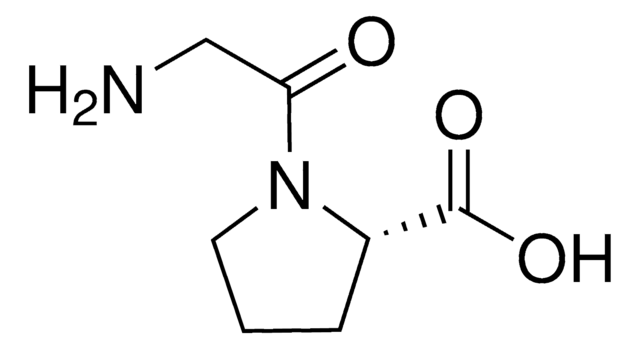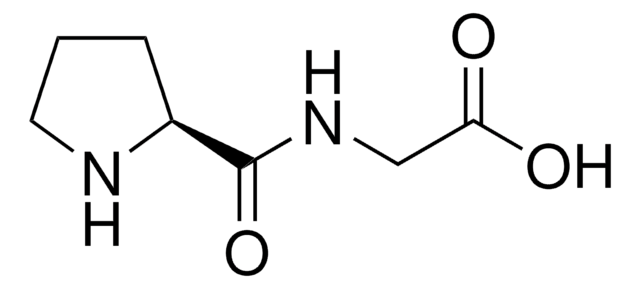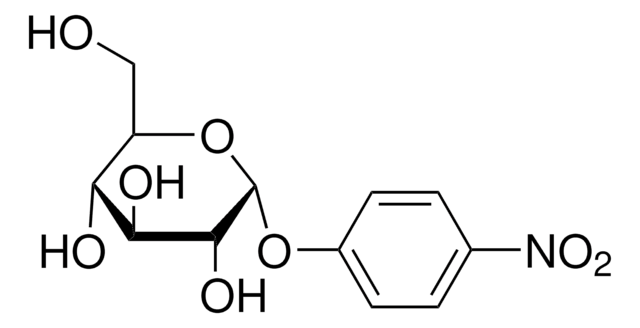L8753
Leu-Pro hydrochloride
Autenticatiper visualizzare i prezzi riservati alla tua organizzazione & contrattuali
About This Item
Formula empirica (notazione di Hill):
C11H20N2O3 · HCl
Numero CAS:
Peso molecolare:
264.75
Numero MDL:
Codice UNSPSC:
12352200
ID PubChem:
NACRES:
NA.26
Prodotti consigliati
Saggio
≥98%
Livello qualitativo
Stato
powder
tecniche
ligand binding assay: suitable
Colore
white
Temperatura di conservazione
−20°C
Stringa SMILE
Cl.CC(C)CC(N)C(=O)N1CCCC1C(O)=O
InChI
1S/C11H20N2O3.ClH/c1-7(2)6-8(12)10(14)13-5-3-4-9(13)11(15)16;/h7-9H,3-6,12H2,1-2H3,(H,15,16);1H
GZEPUBCBTCSTKP-UHFFFAOYSA-N
Categorie correlate
Azioni biochim/fisiol
L-leucyl-L-proline (Leu-Pro) and its retro variant Pro-Leu may be used along with other proline dipeptides to study imprinting and chemotaxis in tetrahymena.
Codice della classe di stoccaggio
11 - Combustible Solids
Classe di pericolosità dell'acqua (WGK)
WGK 3
Punto d’infiammabilità (°F)
Not applicable
Punto d’infiammabilità (°C)
Not applicable
Dispositivi di protezione individuale
Eyeshields, Gloves, type N95 (US)
Scegli una delle versioni più recenti:
Possiedi già questo prodotto?
I documenti relativi ai prodotti acquistati recentemente sono disponibili nell’Archivio dei documenti.
L Köhidai et al.
Cell biology international, 21(6), 341-345 (1997-06-01)
Our investigations demonstrate that proline-containing dipeptides can provoke a chemosensory response from the unicellular Tetrahymena pyriformis. The chemotactic effects of the dipeptides have a close relationship with the side chain and the lipophilicity of the amino-terminal amino acid. Comparison of
Fengxia Zhang et al.
Molecular bioSystems, 6(5), 852-861 (2010-06-23)
A novel metabonomic method based on fast liquid chromatography coupled with ion trap-time of flight mass spectrometry (UFLC/MS-IT-TOF) was applied to study the metabolic changes of plasma and urine in depression and excess fatigue rats. Principal component analysis (PCA) and
G Csaba et al.
Bioscience reports, 17(6), 537-542 (1998-04-30)
Proline-glycine, proline-leucine and proline-valine dipeptides and their retro variants were used in the experiments to study the effects of pretreatment (imprinting) in Tetrahymena, by investigating fluorescein isothiocyanate (FITC)-conjugated peptide binding. The protozoan organism could differentiate between the proline-dipeptides containing different
G Schoetz et al.
Electrophoresis, 22(12), 2409-2415 (2001-08-25)
Dynamic capillary electrophoresis (DCE) and computer simulation of the elution profiles with the theoretical plate and the stochastic model has been applied to determine the isomerization barriers of the three dipeptides L-alanyl-L-proline, L-leucyl-L-proline, and L-phenylalanyl-L-proline. The separation of the rotational
Il team dei nostri ricercatori vanta grande esperienza in tutte le aree della ricerca quali Life Science, scienza dei materiali, sintesi chimica, cromatografia, discipline analitiche, ecc..
Contatta l'Assistenza Tecnica.







